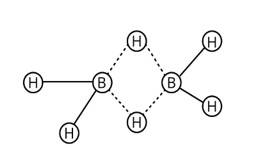In the structure of Diborane
(A) aAll hydrogen atoms lie in one plane and boron atoms lie in a plane perpendicular to this plane.
(B) 2 Boron atoms and 4 terminal hydrogen atoms lie in the same plane and 2 bridging hydrogen atoms lie in the perpendicular plane.
(C) 4 Bridging hydrogen atoms and boron atoms lie in one plane and two terminal hydrogen atoms lie in a plane perpendicular to this plane.
(D) All the atoms are in the same plane.
In the structure of Diborane
(A) aAll hydrogen atoms lie in one plane and boron atoms lie in a plane perpendicular to this plane.
(B) 2 Boron atoms and 4 terminal hydrogen atoms lie in the same plane and 2 bridging hydrogen atoms lie in the perpendicular plane.
(C) 4 Bridging hydrogen atoms and boron atoms lie in one plane and two terminal hydrogen atoms lie in a plane perpendicular to this plane.
(D) All the atoms are in the same plane.
-
1 Answer
-
This is a Multiple Choice Questions as classified in NCERT Exemplar
B
The four terminal hydrogen atoms and two boron atoms are all in the same plane.
There are two bridging hydrogen atoms above and below this plane.
The four terminal B-H bonds are regular two-centre-two-electron bonds, whereas the two bridge (B-H-B) bonds are unique and can be described as three-centre-two-electron bonds, as shown in figure:

Similar Questions for you
This is a Assertion and Reason Type Questions as classified in NCERT Exemplar
(B)
Silicones are a class of silicon polymers that contain the repeating unit (-R 2 SiO-). Silicones are water repellent in nature because they are surrounded by non-polar alkyl groups, so A and R are both correct, but R is not the correct explanation of A.
This is a Assertion and Reason Type Questions as classified in NCERT Exemplar
(A)
In aluminium silicate, silicon is doped with group 13 elements and as aluminium is trivalent and silicon is tetravalent so, on replacing aluminium by Silicon, a negatively charged structure will be obtained. Both the statements assertion and reason are correct and reason is the correct explanation of assertion.
This is a Matching Type Questions as classified in NCERT Exemplar
(i)→ (b), (ii) → (c), (iii) → (b), (iv) → (a) (v)→ (b) (vi)→ (c)
This is a Matching Type Questions as classified in NCERT Exemplar
(i)→ (c) (ii)→ (d) (iii)→ (a) (iv)→ (e) (v)→ (b)
This is a Matching Type Questions as classified in NCERT Exemplar
(i)- (e), (ii)- (c), (iii)- (d), (iv)- (a) & (b)
Taking an Exam? Selecting a College?
Get authentic answers from experts, students and alumni that you won't find anywhere else
Sign Up on ShikshaOn Shiksha, get access to
- 65k Colleges
- 1.2k Exams
- 682k Reviews
- 1800k Answers
